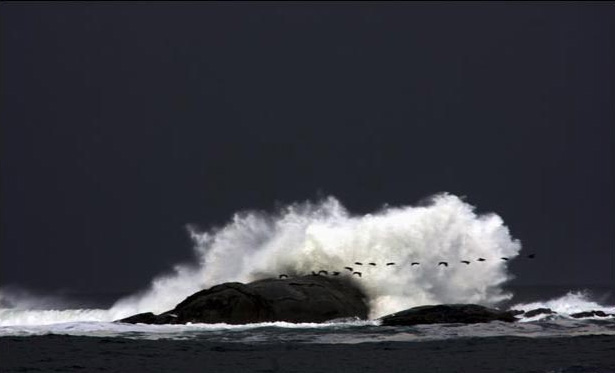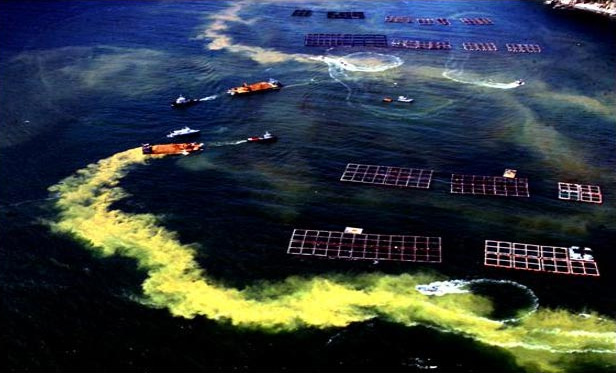
The ocean, as Earth’s source of heat and moisture, stores great amounts of energy which it exchanges with the atmosphere. In the summer, the ocean water absorbs heat from the atmosphere and in the winter supplies heat. In this way, the ocean is both a source and sink for heat.
Moreover, the ocean current delivers large amounts of energy to the Earth’s surface. Warm water from equatorial regions flows to Polar Regions where water is cold. In this manner, the northwestern Pacific Kuroshio current and the north Atlantic Gulf Stream deliver heat to polar areas.
On the other hand, cold currents such as the southeastern Atlantic Benguela current and the northeastern Pacific California current provide cold water to the equator zone. The Atlantic circumpolar current is the source of cold water for all oceans on Earth.
Such distribution of currents enables a balance of heat on Earth. Without it, the tropical regions would get hotter while Polar Regions even colder, thereby significantly reducing the temperate climate regions where most of the population is concentrated.
Heat transfers take place on a large scale in the atmosphere as well. Jet streams in the atmosphere are similar to ocean currents like the Gulf Stream. Jet streams deliver energy from warm equatorial regions to as far as the cold North Atlantic.

Another important interaction that takes place between oceans and the atmosphere is when strong trade wind blowing towards the west pass by the equator region of the Pacific Ocean. In this process, warm surface water is moved far out away from the coast. As a result, cold upwelling currents sprout up near the coast. These currents deliver nutriments to the surface level along the continental shelf, enabling rich fishing grounds. This is why most of ocean fisheries are constrained to relatively small areas.
What would happen to Earth without the atmosphere and oceans? Because the Earth is round, the angle of incidence of solar rays differs by latitude and thus changes the amount of solar energy each unit of land is exposed to. As a result, the equator zone would be searing hot, and the Polar Regions would freeze up.
About 30% of the solar energy that enters Earth gets reflected from ice bergs or scattered due to air molecules, and is emitted out to space again. The remaining 70% of the solar energy gets absorbed by land, atmosphere, or oceans. Energy that the Earth absorbs is eventually emitted to the space again, and these are called Earth radiation.
Because the amount of energy that the Earth absorbs is equivalent to the amount that it emits to space, it is in the equilibrium state. However, there is a difference in the solar radiation that is exposed to each latitude and earth radiation that each latitude emits. Thus, there is surplus energy in low latitudes below 38° and insufficient energy in higher latitudes.
The atmospheric circulation takes place as result of such imbalance and it is through this circulation that the energy imbalance is resolved. In other words, the atmosphere and ocean water at low latitudes with excessive solar energy move towards high latitudes to deliver energy and balance energy globally. In general, the circulation is of air in excessive energy latitudes rising and moving to the Polar Regions while cold air at each pole with insufficient energy is falling.
However, because the Earth rotates, the actual movement of the atmosphere is much more complicated. The atmospheric circulation involves northeast trades in the north hemispheric low latitudes, westerlies in mid-latitudes, and polar easterlies in high latitudes. Meanwhile, the ocean circulation is similar to the atmospheric circulation.
The ocean circulation created by wind is a mixed result of different sea currents and the Earth’s rotation. While the atmospheric circulation follows a path around the entire Earth, the ocean circulation, with the exception of the Antarctic Circumpolar Current, does not take place all over the Earth because continents block the flow.
As explained, the atmospheric and ocean circulation is a process of energy circulation at the global level. The recent increase in temperature on Earth has also led to changes in these circulations. This affects not only regional drought, flood, and desertification but also changes in the weather, indicators, and the climate, all significantly impacting the ecosystem.
The Earth’s environment is composed of atmosphere, hydrosphere, lithosphere, and biosphere. There is a constant circulation of energy and substances between these layers.
Evaporated water in the hydrosphere transfers to the atmosphere as vapor and creates diverse climate phenomena. Circulatingwithin the atmosphere, it eventually returns to the hydrosphere. In this manner, oceans significantly influence the weather.
In the tropical Pacific Ocean, currents generally flow from east to west because trade winds blow from the eastern Pacific to western Pacific. However, for some unknown reasons, the wind blows in the opposite direction every 3 to 8 years. This change is called the Southern Oscillation.
Although trade winds carry a large amount of water to the western Pacific, when the wind weakens, the current slows down and eventually stops, and warm water in the western Pacific flows eastwards.
Because this phenomenon takes place around Christmas, Peruvian fishermen in the 1890s named it El Nino, which means Jesus current. At times of El Nino, temperatures along the coasts of Peru rise by about 0.5℃ above average as warm water from the equatorial Pacific Ocean flows in. In extreme cases, the temperature can rise by 7-10℃. Because of these higher temperature, nutrient salts and dissolved oxygen decreases which leads to less catch and struggling fishing zones. In Central and South America, ascending currents lead to unusual weather such as heavy rain or flooding.

This brings about severe drought in Australia, Indonesia, and the Philippines, which lie on the west of the Pacific Ocean, and accompanies strange weather on both sides of the Pacific Ocean. This change has a significant and damaging impact on the agricultural and fisheries sectors.
The most severe cases of El Nino in the 20th Century took place between 1982 and 1983 and 1997 and 1998. El Nino in 1997 is responsible for about 250,000 flood victims, demolished 16,000 houses, and caused damages 25 trillion KRW in Peru, east of the Pacific Ocean. Meanwhile, many lives were lost to drought in southern Africa and Papua New Guinea, which are located to the west of the Pacific Ocean.
La Nina, which means girl in Spanish, has an opposite effect to the El Nino. The trade wind gets stronger causing higher than average water temperature and sea levels in the west Pacific Ocean. In the equatorial East Pacific Ocean, upwelling intensifies and leads to lower than average water temperatures.
Recent cases of El Nino and La Nina are no longer considered weather changes on a local scale. Rather, the prolonged period at which these weather phenomena occur has significant impacts on global atmospheric circulation. The effects of these phenomena extend from tropical regions to high latitudes and consequently seriously influence the weather and climate of countries around the world.
※ The texts were written based on the outcome of “Development of Ocean Education Textbook” and “Development of Contents for Ocean Education Textbook” projects conducted by the Korea Maritime Foundation in 2010 and 2011